| 1 | Chinese cobra |
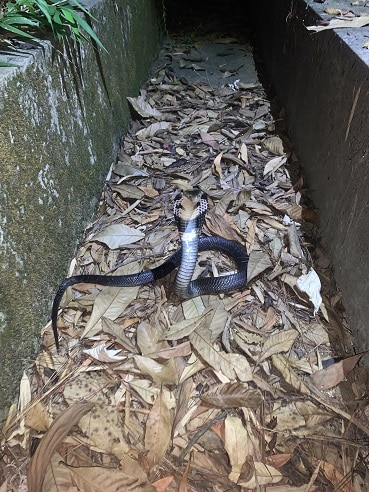
The Chinese cobra (Naja atra) appears all over southern China, and is easily the most common cobra in Hong Kong. They measure 120-150cm, with a maximum of 200cm, and are regularly found slithering through the paved streets of urbanised areas. Theoretically, you could meet the Chinese cobra within an hour of leaving Hong Kong’s main airport.
The Chinese cobra isn’t the deadliest cobra of all time, but certainly shouldn’t be underestimated. Their venom mainly causes necrosis, tearing through skin tissue and possibly necessitating a skin graft. They also possess the ability to spit venom, but with a twist. The Chinese cobra isn’t a true spitting cobra, lacking the standard pressurised holes on the tips of their front fangs. Instead, they have to angle their fangs upward awkwardly, and perform a perfectly executed jump, while simultaneously releasing venom.
More worryingly, Chinese cobras are the second most likely snake in Hong Kong to invade human habitation. Over a 15 year period, 1649 Chinese cobras wormed their way into Hong Kong dwellings, according to a study from January 2002 to December 2016. This was beaten only by the harmless oriental ratsnake (2415). No matter how secure your hotel bed in Hong Kong, you could still wake up to a curious Chinese cobra staring at you.
Despite these dark skills, Chinese cobras kill very few people. A study analysed 242 snakebites in Hong Kong hospitals from 1984-1988 and found just three deaths. One was from the Chinese cobra, another from the Russell’s viper, and another from the white-lipped pitviper.
| 2 | Red-necked keelback |
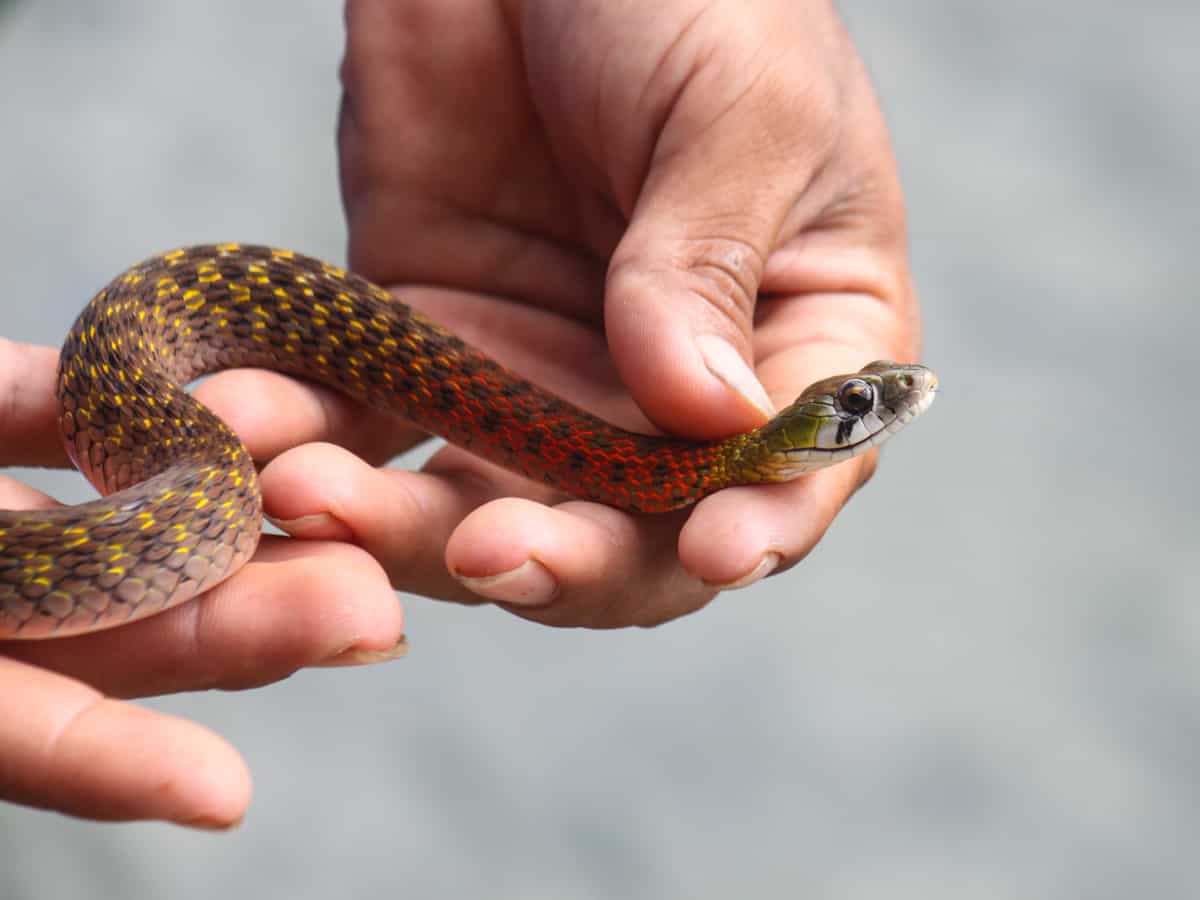
This 60-80cm snake (max 130cm) is one of the few snakes on Earth to contain both venom and poison. Red-necked keelbacks have a bite which can unleash clotting impairment, haemorrhaging, and kidney damage (venom). But they also have the power to swallow poisonous Bufo toads, and sequester their deadly bufotoxins in nuchal glands in their neck (poison). They later burst these toad toxins in people’s faces, using them as an offensive weapon.
Hong Kong is a real hotspot for this snake, and they’re most commonly observed near water sources, which could be a lake, a rice paddy, or as small as a puddle. Red-necked keelbacks are particularly common on Hong Kong’s jogging trails, and can also appear in concrete water culverts in more urbanised areas. With their signature red neck, there’s no snake they truly resemble in Hong Kong.
A threatened red-necked keelback will arch its neck upwards, and release a cloud of deadly bufotoxins, aiming for the predator’s face (sometimes a human). These stored toxins can also be activated by touch, an application of pressure, meaning that picking one up is most unwise.
According to the 2002-2016 study from earlier, red-necked keelbacks invaded Hong Kong households 701 times over 15 years. Despite this, they contribute virtually nothing to Hong Kong’s annual snakebite statistics.
Be careful not to misidentify the red-necked keelback, as they have several weird morphs. One is a melanistic version, where melanin pigments go into overdrive, resulting in total blackness which overrides their usual bright colour palette. This super black morph was photographed in Hong Kong itself.
| 3 | MacClelland’s coral snake |
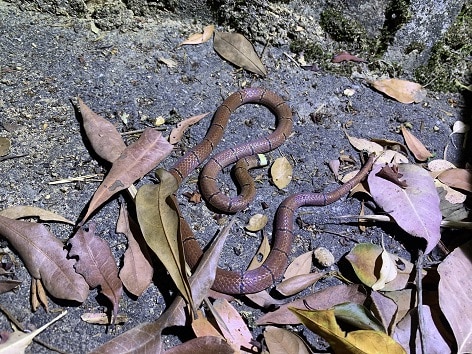
A little researched forest snake measuring up to 84cm, which any sane person should stay well back from. Nobody should approach MacClelland’s coral snake to closer than 1 metre, and the smartest option is to walk right past, with just a quick glance at the serpent that could effortlessly kill you.
MacClelland’s coral snakes (Sinomicrurus macclellandi) are found throughout Hong Kong, but encountered relatively rarely. Their preferred habitats are forests with an abundance of fallen leaves to hide in, and occasionally grassland directly adjacent. They’re also spotted crossing roads near forests, but almost never in urban areas.
MacClelland’s coral snake is part of the 9-member Sinomicrurus genus, and also lives in Thailand and Vietnam. Very few bites are on record for this snake, yet several of those involved death. The symptoms so far have mainly been neurotoxic in nature, initially involving numb lips, difficulty breathing, difficulty speaking and blurred vision.
This snake only invaded Hong Kong households three times from 2002 to 2016. In addition, they’re relatively docile and relaxed, despite their brutal venom. A weird curiosity of MacLelland’s coral snake is that they become extremely alert in the presence of the white-spotted slug snake, a harmless Hong Kong snake. It’s likely that this slug snake forms part of their diet.
| 4 | Many-banded krait |
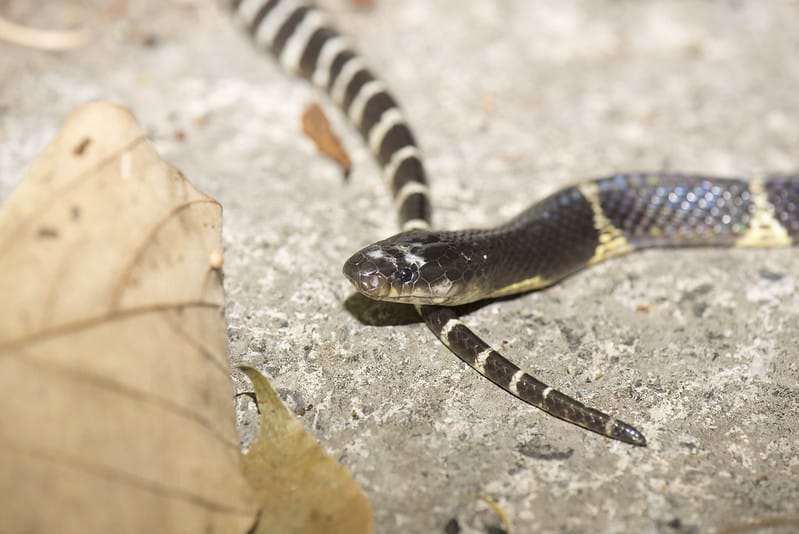
The Bungarus kraits are a venomous group with 16 members in southeast Asia, and the many-banded krait (Bungarus multicinctus) is the most common member in Hong Kong. By raw potency, this species has one of the deadliest venoms of all land snakes (LD50 0.07mg), although the venom yield is very low at just 7mg per bite. This species reaches a maximum of 150cm, and mainly appears in forests and marshes, and occasionally villages.
Many-banded kraits are slow and patient, rarely attacking humans for the sake of it. But picking one up is most unwise, as Bungarus multicinctus has a freakishly flexible neck which allows them to twist at nightmarish angles and bite your hand, even if held with a firm grip.
The area surrounding the bite is rarely painful, with a moderate itching at most. Instead, the symptoms are delayed, usually arriving 1-4 hours post bite. The symptoms are strongly neurotoxic in nature, including dilated pupils and breathing woes. The main toxins are the beta-bungarotoxins, representing 50% of the total, followed by alpha-bungarotoxins and a trace of K-bungarotoxins (0.1%).
Beware of any black and white banded snakes in the territory of Hong Kong. There’s also harmless mimics, such as the Futsing wolf snake, which has extremely similar patterns. The key is a larger white patch on the head, but it’s wiser to be cautious and stand well back from any black-white snakes.
| 5 | White-lipped pitviper |
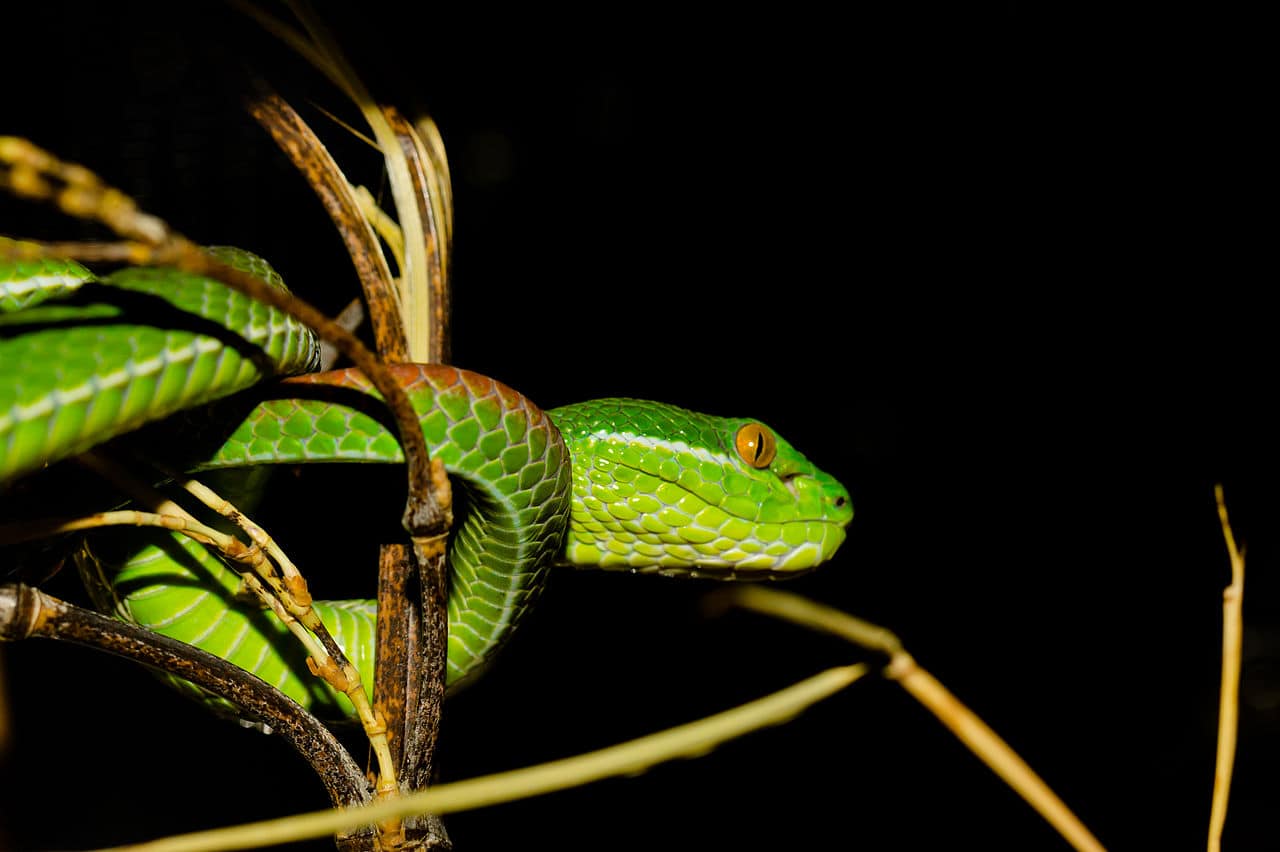
The most common venomous snake in Hong Kong, and the chief architect of bites. White-lipped pitvipers inhabit every region of Hong Kong, and reach a maximum length of 104cm. With the exception of dense forests and concrete jungles, they can live in virtually any habitat, including gardens, parks, villages, wooded hillsides and jogger’s trails alike.
White-lipped pitvipers are a branch-dwelling species, which usually sticks to heights of 50-300cm above ground. Coincidentally, this is the perfect height for biting people walking past. Their venom has almost no neurotoxins, but causes a catastrophic swathe of swelling and necrosis, physically dissolving skin tissue bonds using an elixir of metalloproteinases.
The most overwhelming danger statistic came from 2009, when Trimeresurus albolabris made up 95% of venomous bites in Hong Kong, of 139 in total. A study from 1982-1986 discovered 242 snakebites in Hong Kong, and found that “the White-lipped pit viper (Trimeresurus albolabris) was by far the commonest species involved“. Fortunately, they only caused one death.
Another study examined snakebite in children in rural Hong Kong. Over 10 years, just 7 children were bitten, but most bites came from the white-lipped pitviper.
The home invasion survey found that this species invaded households 1164 times from 2002-2016. This was well behind the Chinese cobra (1649), yet the white-lipped pitviper still dwarfs them in actual bite totals. A survivable species, yet a vicious one.
| 6 | Common mock viper |
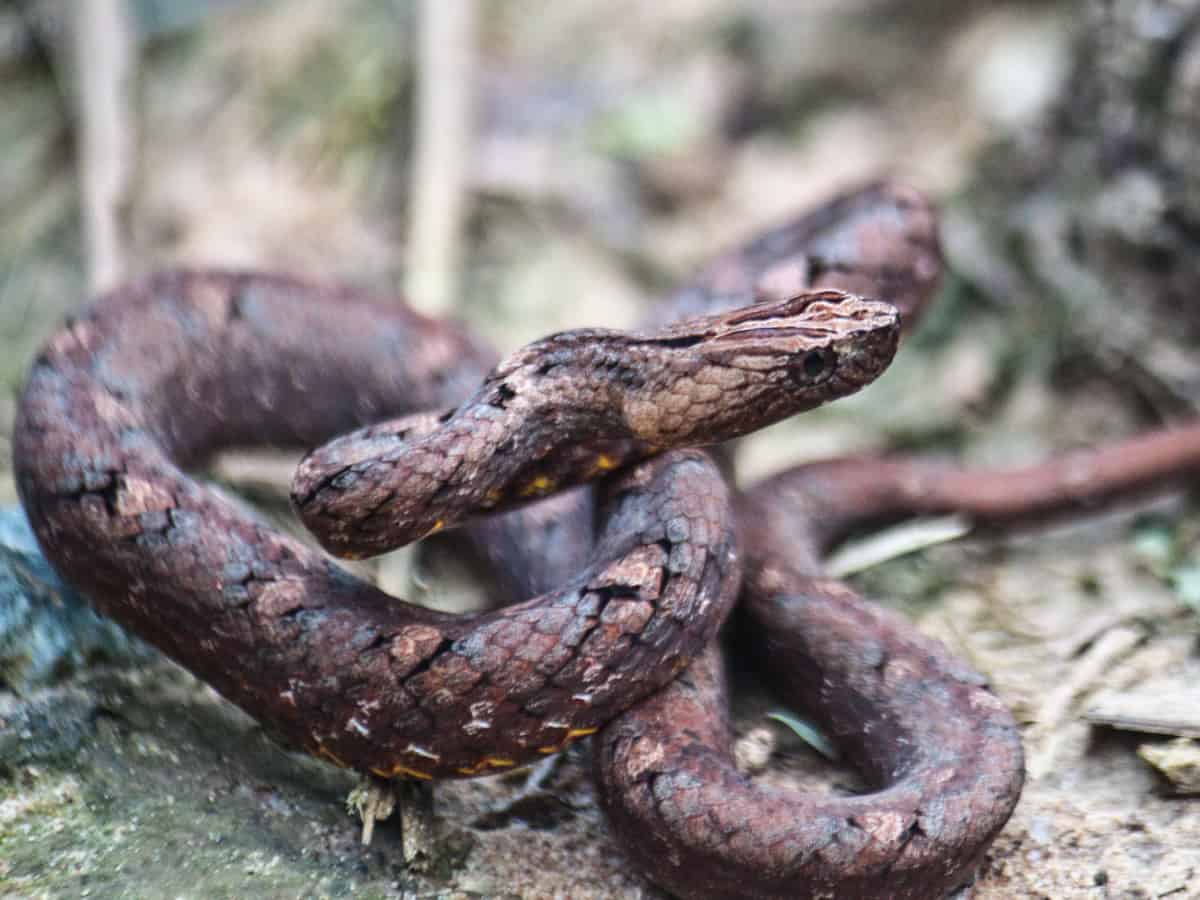
A widespread species in southeast Asia, which has a stronghold in Hong Kong. This species survives by mimicking dangerously venomous vipers, both in appearance and mannerisms. There’s the sharply vertical pupils, murky grey patterns, and a head which can flatten and become more triangular. They also copy the classic S-shaped strike pose of a viper, with the goal of tricking their enemies.
However, common mock vipers (Psammodynastes pulverulentus) also have a venom of their own, albeit a mild one. There are no cases of serious reactions in humans, let alone death. Bites tend to bleed heavily and swell up in the surrounding area. Common mock vipers tend to be feisty and snap when first confronted, but calm down over time.
This is an active snake which confidently explores the forests of Hong Kong, only occasionally hiding under cover. Psammodynastes pulverulentus is an energetic snake, which reacts quickly to stimuli like a pair of steel snake tongs. They’re particularly abundant in Tai Po Kau Nature Reserve in central Hong Kong, and appear in urban streets only rarely.
From 2002 to 2016, common mock vipers were caught in Hong Kong households just 38 times. This species averages at 50-70cm (maximum 77cm), and has a reddish tint to its eye when viewed up close.
| 7 | Banded krait |
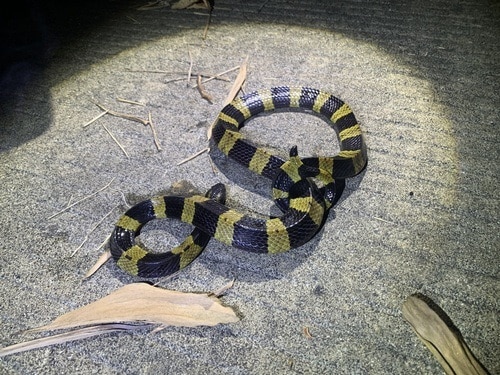
Another member of the neurotoxic Bungarus genus, and another severely deadly one. The banded krait (Bungarus fasciatus) is far less common in Hong Kong than the many-banded krait. They’re slightly less dangerous, but a banded krait bite is still potentially life threatening and requires immediate hospitalisation. Banded krait venom contains both post and pre-synaptic neurotoxins, a perfect elixir for lung failure and paralysis.
Bungarus fasciatus averages at 105-135cm, with a maximum of 212.5cm. This is mainly a calm snake, investigating the forest floor for its main prey, fellow snakes. But when confronted, this species flies into a frenzy. The banded krait shakes its head from side to side, makes sharp stabbing lunges, and acts extremely erratically. They’ll sometimes coil up tightly and wave their tail around as a distraction. This tail is rounded, and resembles a small head, luring predators away.
Jogging trails are a likely place to find Bungarus fasciatus, but as they’re nocturnal, and rarely invade houses, encounters are far less common than with white-lipped pitvipers.
Bungarus fasciatus is easy to distinguish from the many-banded krait, as its pale sections are bright yellow instead of white. It’s also slightly thicker, and has a keeled spine which makes it look triangular (noticeable in the image above).
| 8 | Chinese watersnake |
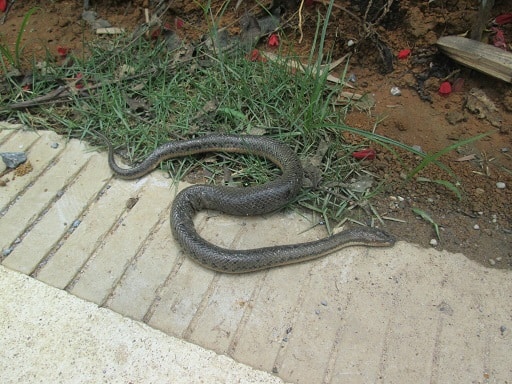
This 30-50cm (record 61cm) species is found in water bodies across Hong Kong, as well as southern China and Taiwan. Myrrhopis chinensis is comfortable in manmade water bodies such as fish ponds and rice paddies, as well as natural water bodies such as lakes and slow-moving rivers.
The Chinese water snake (Myrrhopis chinensis) has a twitchy temperament. They produce a foul snake smell to defend themselves, and they bite interlopers readily. Though no deaths have occurred, they have a mild venom, which causes pain and moderate swelling at the bite site. No detailed analysis of the venom has ever been conducted, so there may be mysteries yet to discover in this semi-aquatic Hong Kong serpent.
Myrrophis chinensis isn’t found in every region of Hong Kong. It’s believed to be missing from Hong Kong Island, and is mainly found in the north and west. But where it does exist, it dwells in large numbers. This species also has the ability to launch leaping strikes.
Despite their watery ways, Chinese watersnakes were recorded invading human habitation 18 times from 2002 to 2016. They aren’t completely restricted to water, and will sometimes appear in urban zones.
| 9 | Tonkin pitviper |
One of Hong Kong’s less common venomous snakes. The Tonkin pitviper (Ovophis tonkinensis) is a particular lover of rock crevices, and it’s these shadowy habits which make them hard to find. They never appear in urban areas, preferring to rest on rock formations in moist forests, usually close to a water source. This species is most commonly spotted during colder months.
Ovophis tonkinensis lives so remotely that it has virtually no presence in Hong Kong’s annual snakebite statistics. It’s known that their venom is mainly procoagulant, rapidly overusing clotting agents such as fibrin and prothrombin so that virtually none are left, causing even minor cuts to readily bleed.
Tonkin pitvipers have an unpredictable temperament. They may attempt to flee, but they may also stand their ground, and jab at the air sharply in a series of rapid strikes.
Ovophis tonkinensis measures 30-50cm, with an absolute record of 95cm, and could never be confused with a Chinese cobra or many-banded krait. They have distinctive orange scales overlaid with messy black blotches, with white patches on their face. They have grey eyes with a sharply vertical pupil, and as this video shows, they slither slowly and patiently. This is a confident viper which is in no frantic dash to secure its prey. Being so shy, useable images are hard to come by, so check out this footage instead.
| 10 | Many-spotted catsnake |
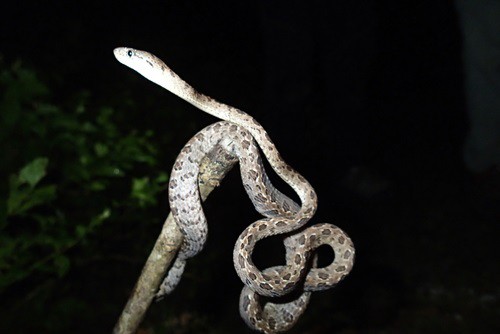
One of Hong Kong’s most strictly nocturnal snakes. The many-spotted catsnake (Boiga multomaculata) clings to tree branches for hours at a time, and is a relatively large species with a maximum of 187cm. This is an abundant species in Hong Kong, inhabiting every region, including Lantau Island and Hong Kong Island. Despite their love of trees, they avoid the densest forests, preferring to stick to moderate woodland and tree clumps near grassy fields and shrubland.
Boiga multomaculata secretes a rear-fanged venom which must be chewed in repeatedly to enter the bloodstream. While originally assumed to be weak, analysis of several other Boiga catsnakes has revealed some surprisingly strong venoms recently. These included the gold-ringed catsnake and black-headed catsnake, so it’s possible that the many-spotted catsnake also has tricks up its sleeves. Either way, this Hong Kong snake has never caused a recorded human death.
Many-spotted catsnakes are found in Thailand, Vietnam and Cambodia. Hong Kong lies in the easternmost extent of their territory, yet may have the most sightings of all, as though it’s one final stronghold before the uninhabitable badlands of rival catsnakes kick in. They’ve been spotted in the Education University of Hong Kong, but will never be found slithering down a bustling high street. Many-spotted catsnakes invaded Hong Kong households 132 times from 2002 to 2016, according to the same study from earlier.
